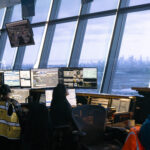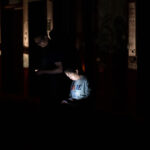A second beam in San Francisco’s celebrated new $2 billion transit terminal shows signs of cracking, an official said Wednesday, a day after a crack in a nearby support beam shut down the building that opened just last month.
The first crack found by workers installing roof tiles Tuesday spans a beam holding up a park over the three-block-long facility and runs over a downtown street, Salesforce Transit Center executive director Mark Zabaneh said.
He said the problems were localized to that area of the transit hub but it would remain closed “at least through the end of next week” as inspections continued. It’s not yet clear what caused the cracks.
Mayor London Breed said the facility would stay closed until it was safe to reopen. Its role in the broader transportation system is too important “not to act quickly to have definitive answers for the public, and someone needs to be held accountable once the cause is determined,” she said in a statement.
Engineers decided to shut down the station around 5 p.m. Tuesday, just as rush hour started, out of an “abundance of caution,” Zabaneh said.
“The behavior of the beam is unpredictable,” he said.
The transit hub, a commanding presence in the city’s South of Market neighborhood where construction is booming, sits adjacent to the so-called sinking condominium, Millennium Tower, which has settled about 18 inches (45 centimeters) since it opened over a former landfill in 2009.
Homeowners have filed multiple lawsuits against the developer and the city, some alleging that construction of the transit center caused the Millennium Tower to sink.
Zabaneh said he did not believe the cracked beam was related to ongoing problems at Millennium Tower.
The crack was found near a weld on a stress-bearing horizontal beam, Zabaneh said. Engineers are searching for other cracks in other pipes but are optimistic the damage is limited to the one beam.
Buses were rerouted to a temporary transit center about two blocks away that was used during the center’s construction. A downtown street that runs under the beam also was ordered closed indefinitely, causing traffic chaos at the same time some streets were closed for a conference sponsored by Salesforce that was expected to draw 170,000 attendees.
Enveloped in wavy white sheets of metal veil, the five-level center includes a bus deck, a towering sky-lit central entrance hall and a rooftop park with an outdoor amphitheater. Zabaneh said American steel was used in the center’s construction.
“A structural steel beam should never crack,” Joe Maffei of Maffei Structural Engineering told the San Francisco Chronicle.
The newspaper previously reported that the complex faced delays in putting out contracts to bid, and the winning bids were ultimately higher than expected.
The terminal’s cost rose from $1.6 billion at its 2010 groundbreaking to more than $2 billion in 2016 because of what one analyst called “optimistic assumptions,” according to the Chronicle.
The project is financed by land sales, federal stimulus grants, district fees and taxes, bridge tolls, and federal and state funds.
Numerous towering condo buildings have gone up in the booming South of Market neighborhood in the last five years and several multistory construction projects are still underway as San Francisco lures technology companies from Silicon Valley to the neighborhood.
The online business software company Salesforce, which opened its adjacent 61-story Salesforce Tower earlier this year, bought naming rights to the transit center in 2017 as part of a 25-year, $110 million sponsorship agreement.
The Salesforce Transit Center is operated by the Transbay Joint Powers Authority.
Was this article valuable?
Here are more articles you may enjoy.

 Duffy Says ‘Several Weeks’ of Flight Cuts Needed at Newark
Duffy Says ‘Several Weeks’ of Flight Cuts Needed at Newark  Newark Backup Data Line Failed Before 90-Second Radar Outage
Newark Backup Data Line Failed Before 90-Second Radar Outage  Spain Blackout Shows Need for Batteries in Renewable-Heavy World
Spain Blackout Shows Need for Batteries in Renewable-Heavy World  As Execs Eye AI for Fraud Detection, Deloitte Predicts Billions in Savings
As Execs Eye AI for Fraud Detection, Deloitte Predicts Billions in Savings 